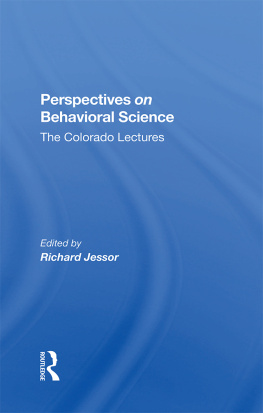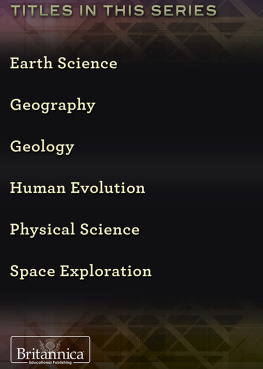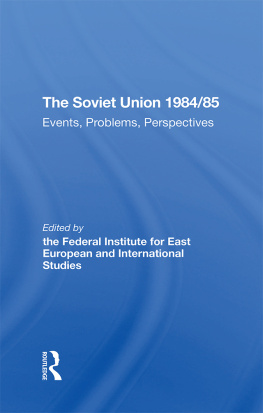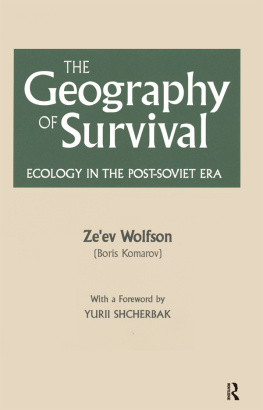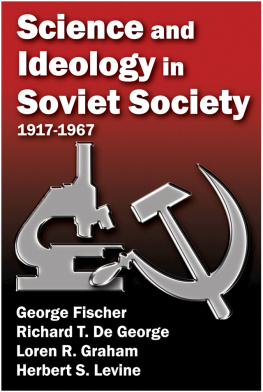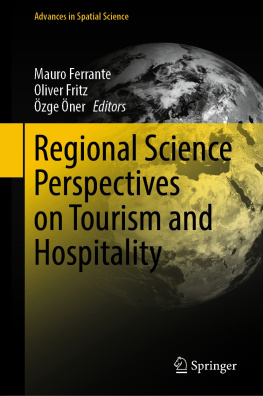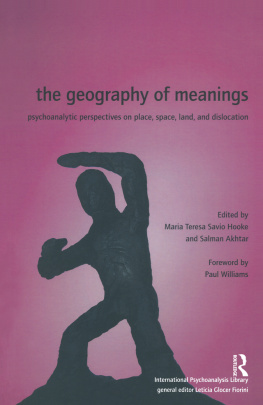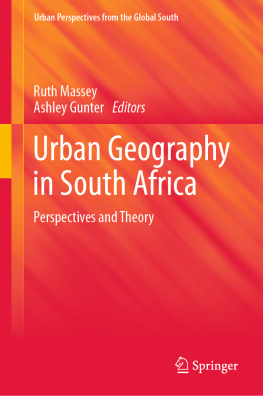First published 1992 by Westview Press
Published 2019 by Routledge
52 Vanderbilt Avenue, New York, NY 10017
2 Park Square, Milton Park, Abingdon, Oxon OX14 4RN
Routledge is an imprint of the Taylor & Francis Group, an informa business
Copyright 1992 by Taylor & Francis
All rights reserved. No part of this book may be reprinted or reproduced or utilised in any form or by any electronic, mechanical, or other means, now known or hereafter invented, including photocopying and recording, or in any information storage or retrieval system, without permission in writing from the publishers.
Notice:
Product or corporate names may be trademarks or registered trademarks, and are used only for identification and explanation without intent to infringe.
Library of Congress Cataloging-in-Publication Data
The art and science of geography: U.S. and Soviet perspectives /
edited by Vladimir V. Annenkov, George J. Demko.
p. cm.
ISBN 0-8133-8516-4
1. GeographyUnited States. 2. GeographySoviet Union.
I. Annenkov, Vladimir V. II. Demko, George J., 1933- .
G99.A78 1992
910dc20 91-38970
CIP
ISBN 13: 978-0-367-29024-5 (hbk)
International comparisons between the concepts and practice of geographers are always difficult. The language barriers and the social and scientific contexts differ so much that it is awkward to assess similarities. Are such similarities real or only apparently real? Is the logic behind the different approaches based on the same principles? In order to avoid mistakes and to generate satisfactory interpretations it is necessary to have some perspective on the sociology of knowledge in the countries that are being compared.
The major goal of this book is to provide explanatory statements about the discipline and, at the same time, to convey a feeling of the differences between intellectual atmospheres in the two countries. The similarities are more numerous than might be expected from nations with such different histories and so few scientific interactions during the past fifty years. Soviet and American geographers have coincident views concerning the development of geography: a significant change occurred during the last generation with the increased use of quantitative techniques and satellite imagery, a growing interest in theory, and more sophisticated modes of explanation. And, there is agreement on the significance of the new methodologies and their impact on the development of the discipline. Some comments, American as well as Soviet, are more cautious: geography will need, in the future, increasingly efficient tools to acquire and to process data; geographers will rely increasingly on their numeracy, but at the same time, progress will depend on an improved capability to decipher processes and to build theories. The significance of the "postmodernist" approach is presented by V. L. Kagansky. On the American side, A. Pred is very vocal when stigmatizing the dangers of over-technical forms of geographical development.
The United States and USSR have operated in very different intellectual contexts during their history and their institutions have few, if any, similarities. What is striking in such a situation is how analogous the positions of American and Soviet geography are within both their national scientific contexts. Geography is experiencing problems regarding its scientific status and scientific visibility both in the United States and in the Soviet Union: the quality of the geographers and of the geography which they practice is, however, not responsible for this situation. The problem is rooted in the nature of geography as a discipline and of its relationship with other disciplines, both in the natural and the social sciences, especially the fact that geography is both a natural and social science.
The final similarity relates to geography in the schools. Differences seem extraordinary: In America, geography is practically absent from the secondary school curricula; in the Soviet Union, geography is taught at every level. But in both countries, school geography is undergoing similar difficulties. The geography taught in both nations is not adequate for today's social needs. It still relies too heavily on the traditional views in the discipline, hence there is a great necessity to promote, in both countries, new curricula and to improve the skills of people in charge of the teaching of geography.
The differences between Soviet and American geography, however, are as significant as the similarities. The concepts of geography differ widely in the two countries. If we accept the idea that geography is made up of two complementary parts, the study of vertical (or ecological) relations between man and environment, and the study of horizontal (or social) relations between humans and between groups, Soviet geographers put more emphasis on the first aspect, and Americans have a more balanced, or even a slightly more social science approach to the field. At the same time, when reading the answers to the question "How is the discipline of geography defined?" one becomes aware of the importance of institutional backgrounds in the way geography is practiced. Soviet geographers rely on a universally accepted paradigm of the core of the discipline: they all speak of the "landscape mantle" of the earth. Their answers convey the feeling that they have been trained in a coherent academic discipline, with clear definitions of its aims and scope. American answers give a different view: as geographers, they have not been trained according to uniform principles; geography is for them a looser construct, and their definitions are more derived from their personal experience in the field and in various schools of research, rather than from a uniformly agreed-upon core.
Differences between the two sets of responses do not proceed only from the different academic environments in the two countries. They also reflect the emphasis given to ecology. Soviet geographers are more interested in ecological problems, although some Americans have similar attitudes: the view of John R. Mather, for instance, is sometimes parallel to the prevailing Soviet ones. In the USSR, some geographers are more aware of the historical and social dimensions of geographical phenomena and thus closer to the prevailing American views: such is the case of Vladimir Annenkov or of V. L. Kagansky, for instance.
Soviet responses provide us with a view of the major achievements of Soviet research in the field of environmental preservation. The statements, especially of V. V. Vorobyov, B. B. Prokhorov and A. M. Trofimov, and R. G. Khuzeyev (as well as others) describe the impact of Soviet geographical research on the preservation of environments and on the management of natural resources. I am not sure that Western geographers are fully aware of the quality of this kind of research and of its implications. Soviet geographers played a decisive role in making Soviet citizens conscious of the problem of their environment: it is an outstanding success!
This interest in natural preservation is also central in K. Ya. Kondratiev's studies on the global consequences of nuclear warfare. It is certainly one of the fields where Soviet geography achieved impressive results.




